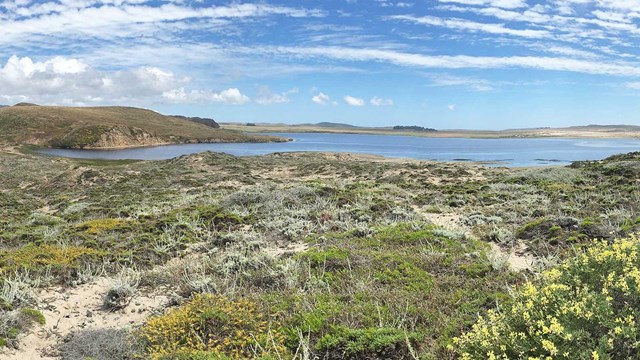
Plant Community Monitoring
Dig in to monitoring protocols, reports, and more on the San Francisco Bay Area Network's Plant Community Monitoring page. 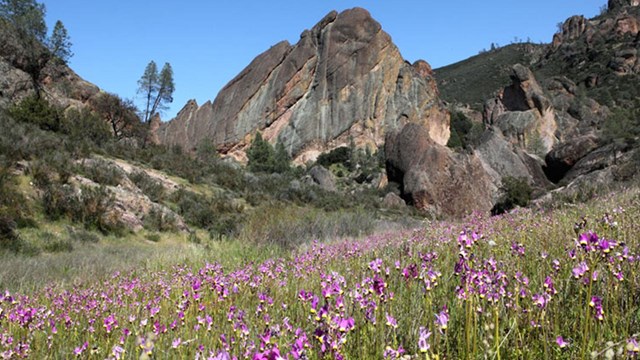
Plant Communities in the SF Bay Area
Learn more about plant communities around the Bay Area from the Pacific Coast Science & Learning Center website. Habitats of Pinnacles: The Vegetation of the ParkAn Overview of Vegetation TypesVegetation at Pinnacles National Park can be grouped into five major habitat types or vegetation associations, each representing a unique blend of plant communities. These associations result from a complex web of interactions among the various plant species and are influenced by a range of abiotic (non-living) factors, including soil type, slope, exposure direction, moisture availability, and fire history. By understanding the plant species that define each association, we can recognize patterns that reveal the interconnectedness of habitats and ecosystems within the park. 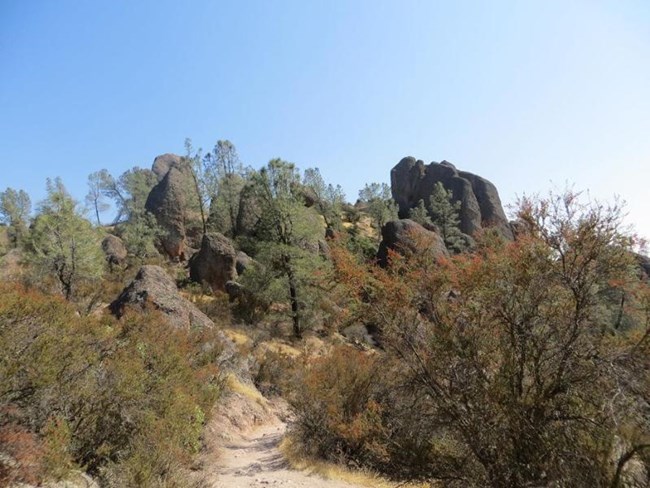
NPS Chaparral: The Dominant Vegetation of Pinnacles National ParkOverview of the Chaparral CommunityChaparral is the most widespread plant community at Pinnacles National Park, covering approximately 82% of the park’s landscape. This resilient vegetation type thrives across various environments, from shallow to deep soils, north- or south-facing slopes, moist canyon bottoms, and exposed upper ridges. Despite the differences in location, all chaparral associations share similar traits, with variations in species composition and structure influenced by environmental factors. Adaptations for SurvivalChaparral plants are primarily shrubs that grow up to two meters tall, adapted to the park’s warm climate, characterized by hot, dry summers and cooler, wetter winters. To endure the long, arid summers, many species have developed specialized traits, such as small, waxy-coated leaves to reduce water loss, deep taproots to access underground moisture, shrubby stature for resilience, and water storage structures. Some even enter summer dormancy to conserve resources. Fire Adaptation and RegenerationFire plays a crucial role in the chaparral ecosystem. Many chaparral species have evolved to depend on periodic fires for regeneration. Some seeds remain dormant in the soil for years, only germinating when a fire triggers their growth. These plants, adapted for disturbance and seed coat scarification, often reappear in areas where they have long been absent, responding quickly to the environment after a fire. Dominant Species and Plant DiversityThe most dominant shrub in the chaparral community at Pinnacles is chamise, which has small, needle-like leaves. Chamise produces spikes of white flowers that bloom at the tips of its branches from May through July. It often grows alongside other species, including buck brush, manzanita, holly-leaved cherry, mountain-mahogany, and black sage. Variation Across the LandscapeThe composition of chaparral varies based on soil type, slope exposure, and other environmental factors. The diversity of the annual and perennial understory also depends on moisture availability and exposure. Generally, drier, south-facing chaparral stands support fewer species, while the moister, north-facing stands host a richer variety of plants. 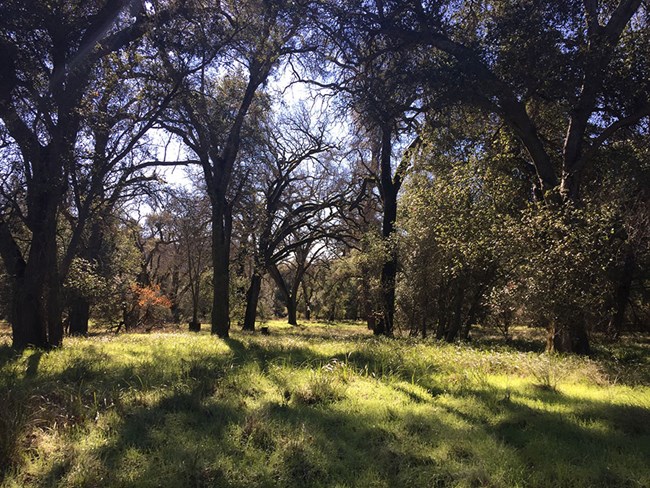
NPS / Cindy Martinez Woodlands: The Second Most Common Vegetation at PinnaclesOverview of Woodland HabitatsWoodlands are the second most prevalent vegetation association at Pinnacles National Park, extending from the lower riparian areas to the upper exposed slopes of North Chalone Peak. This habitat is defined by tree species with a diverse understory of annual grasses and forbs. Woodland areas account for about 10 percent of the park’s vegetation, with blue oak woodlands being the most prominent type. Dominant and Minor Tree SpeciesThe primary woodland association in the park is composed of blue oak. In addition, other tree species like gray pine, California buckeye, valley oak, and live oak are present within both woodland and riparian areas. However, while these species are major components in riparian zones, they play a less dominant role in the woodland habitat, where blue oak is most prevalent. Understory CompositionThe woodland understory features a mix of non-native grasses, native perennial grasses, and a variety of annual and perennial forbs. This diverse blend of grasses and forbs supports the ecosystem, providing habitats and resources for numerous wildlife species and contributing to the dynamic landscape of Pinnacles’ woodlands. 
Photo by NPS/Kurt Moses Riparian Habitats: The Lush Valleys and Canyons of PinnaclesOverview of Riparian ZonesRiparian habitats in Pinnacles National Park are confined to the valley bottoms and sheltered, moist canyons. These areas support plant species that are deep-rooted and have higher water requirements than any other vegetation association in the park. Due to their proximity to creeks and streams, riparian zones provide a vital and lush environment within the park's diverse landscape. Dominant Tree SpeciesLarge deciduous and evergreen species are prominent in the riparian habitat. Trees such as sycamore, cottonwood, and California buckeye often grow directly along the banks of small creeks and streams. Other significant species include valley oak, live oak, gray pine, willow, and mule fat, all of which thrive in these water-rich environments and contribute to the dense canopy characteristic of these areas. Understory VegetationThe understory of riparian habitats consists mainly of shade-loving perennial plants, adapted to the cooler, sheltered environment provided by the overhead canopy. Unlike other habitats in the park, the riparian zones have few annual species, focusing instead on perennial plants that are well-suited to the consistent moisture levels and shaded conditions. This diverse understory supports a variety of wildlife, making riparian areas some of the most biologically rich habitats in Pinnacles National Park. 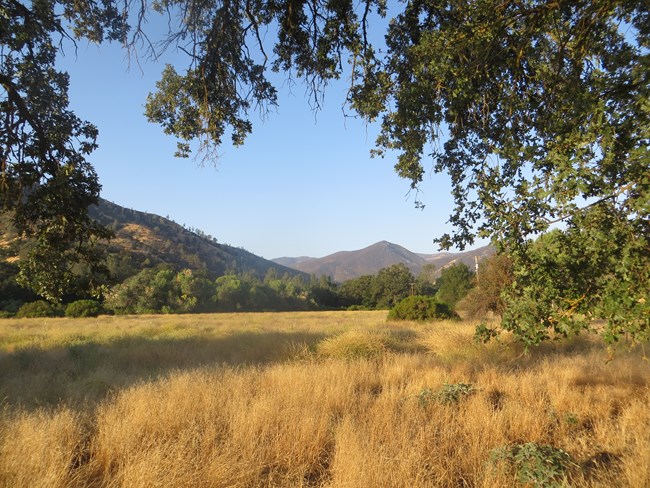
NPS / Emily McDermott Grasslands: The Open Fields of PinnaclesOverview of Grassland HabitatsGrasslands at Pinnacles National Park are typically found in areas similar to those of the rock and scree association and are closely related to this habitat type. These grasslands develop on shallow soils, which inhibit the establishment of deep-rooted species, resulting in a community dominated by grasses and herbaceous plants that are adapted to these conditions. Dominant Plant SpeciesThe grasslands are characterized by a mix of native and introduced species. Introduced grasses, such as brome, are prevalent, alongside native and non-native annuals like fiddleneck and filaree. These annuals thrive in the open, sunny environment that the grasslands provide. In addition, a variety of mostly native herbaceous perennials, including lomatiums, add to the diversity of these fields. These species are well-suited to the dry, shallow soils and provide vital habitats for wildlife, creating a dynamic and ever-changing landscape in Pinnacles National Park. 
Photo by NPS / Cindy Martinez Rock and Scree: The Rugged Terrain of PinnaclesOverview of the Rock and Scree HabitatAlthough the rock and scree habitat is the least common in Pinnacles National Park, its dramatic spires and exposed rock faces are central to the park’s identity and inspired its establishment. This habitat is named for its predominant substrate, characterized by little or no soil, which sets it apart from other habitat types like grasslands. The minimal soil depth influences the types of vegetation that can survive here, leading to a unique and specialized plant community. Plant Adaptations and DiversityDespite the challenging conditions, several plants have adapted to thrive in this harsh environment. Species such as bitterroot and two-leaved onion are among the most striking plants in the park and are found in the rocky areas of the High Peaks, Balconies, and South Chalone Peak. These plants have evolved specialized traits to survive the minimal soil and exposure to wind and sun, making them some of the most resilient species in Pinnacles. This habitat showcases the adaptability of life in extreme conditions and highlights the park’s unique geological and botanical diversity. |
Last updated: October 18, 2024
